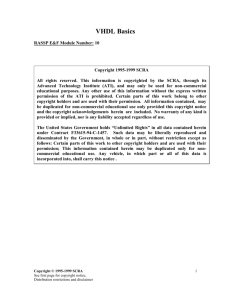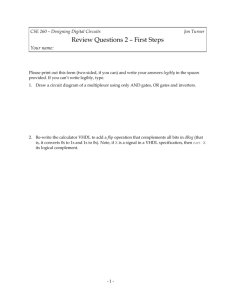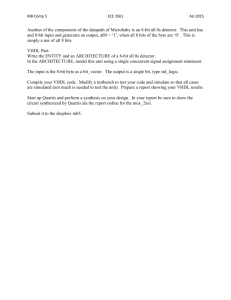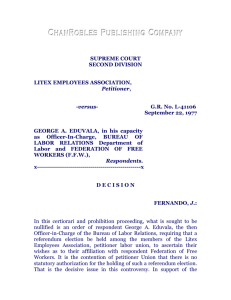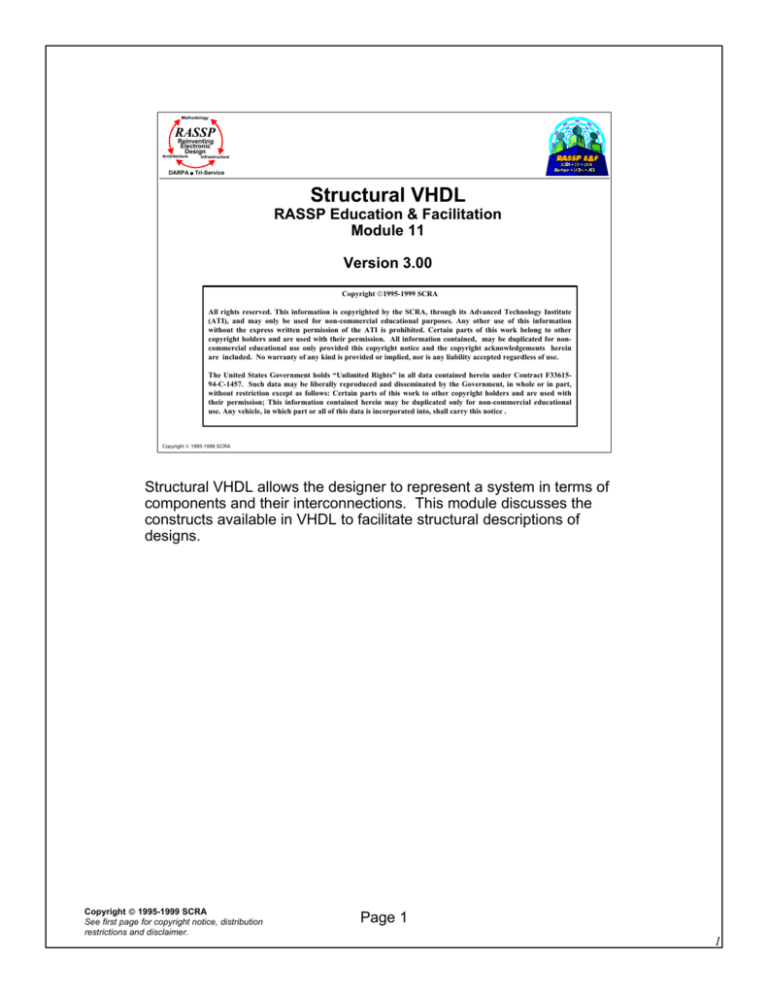
Methodology
RASSP
Reinventing
Electronic
Design
Architecture
DARPA
Infrastructure
Tri-Service
Structural VHDL
RASSP Education & Facilitation
Module 11
Version 3.00
Copyright 1995-1999 SCRA
All rights reserved. This information is copyrighted by the SCRA, through its Advanced Technology Institute
(ATI), and may only be used for non-commercial educational purposes. Any other use of this information
without the express written permission of the ATI is prohibited. Certain parts of this work belong to other
copyright holders and are used with their permission. All information contained, may be duplicated for noncommercial educational use only provided this copyright notice and the copyright acknowledgements herein
are included. No warranty of any kind is provided or implied, nor is any liability accepted regardless of use.
The United States Government holds “Unlimited Rights” in all data contained herein under Contract F3361594-C-1457. Such data may be liberally reproduced and disseminated by the Government, in whole or in part,
without restriction except as follows: Certain parts of this work to other copyright holders and are used with
their permission; This information contained herein may be duplicated only for non-commercial educational
use. Any vehicle, in which part or all of this data is incorporated into, shall carry this notice .
Copyright 1995-1999 SCRA
Structural VHDL allows the designer to represent a system in terms of
components and their interconnections. This module discusses the
constructs available in VHDL to facilitate structural descriptions of
designs.
Copyright 1995-1999 SCRA
See first page for copyright notice, distribution
restrictions and disclaimer.
Page 1
1
Methodology
RASSP
Reinventing
RASSP Roadmap
Electronic
Design
Architecture
DARPA
Infrastructure
Tri-Service
RASSP DESIGN LIBRARIES AND DATABASE
Primarily
software
HW
DESIGN
SYSTEM
DEF.
FUNCTION
DESIGN
Primarily
hardware
VIRTUAL PROTOTYPE
HW
FAB
INTEG.
& TEST
HW &
SW
PART.
SW
DESIGN
HW & SW
CODESIGN
SW
CODE
VHDL
VHDL
Copyright 1995-1999 SCRA
This diagram emphasizes the role of VHDL in the RASSP program.
VHDL can be used for system definition, functional design, hardwaresoftware partitioning, hardware design and hardware-software
integration and test. In RASSP, the concept of virtual prototyping uses
VHDL as the binding language of choice for all design paradigms.
The most common usage of VHDL prior to RASSP was in the area of
hardware design. The RASSP program has extended VHDL's use to
include executable requirements, performance modeling/system level
design as well as system integration and test.
Copyright 1995-1999 SCRA
See first page for copyright notice, distribution
restrictions and disclaimer.
Page 2
2
Methodology
RASSP
Reinventing
Electronic
Design
Architecture
DARPA
Infrastructure
Module Goals
Tri-Service
●
Introduce structural VHDL constructs
Use of components
Component binding indications
❍ Use of configuration declarations
❍ GENERATE statements
❍
❍
Copyright 1995-1999 SCRA
The goals of this module are to introduce the concepts and constructs
supporting structural modeling using VHDL. These include the
mechanisms for incorporating other VHDL design objects into an
architecture description. In addition, some powerful VHDL utilities that
facilitate the design of systems with regular structures and constructs to
support configuration control will be presented. The goal of this module
is to bring the student to the point where she/he will be able to write
code using the concepts of structural design in VHDL.
Copyright 1995-1999 SCRA
See first page for copyright notice, distribution
restrictions and disclaimer.
Page 3
3
Methodology
RASSP
Reinventing
Electronic
Design
Architecture
Infrastructure
DARPA
Module Outline
Tri-Service
●
Introduction
●
Incorporating VHDL Design Objects
●
Generate Statement
●
Examples
●
Summary
Copyright 1995-1999 SCRA
Copyright 1995-1999 SCRA
See first page for copyright notice, distribution
restrictions and disclaimer.
Page 4
4
Methodology
RASSP
Reinventing
Putting It All Together
Electronic
Design
Architecture
DARPA
Infrastructure
Tri-Service
Package
Generics
Architecture
Ports
Entity
Architecture
Architecture
(structural)
Concurrent
Statements
Copyright 1995-1999 SCRA
Concurrent
Statements
Process
Sequential Statements
This figure captures the main features of a complete VHDL model. A single component model
is composed of one entity and one or many architectures. The entity represents the interface
specification (I/O) of the component. It defines the components external view, sometimes
referred to as its "pins".
The architecture(s) describe the function or composition of an entity. There are three general
types of architectures. One type of architecture describes the structure of the design (right
hand side) in terms of its sub-components and their interconnections. A key item of a structural
VHDL architecture is the ”binding statement" which associates the entity of a sub-component to
one of the possible several alternative architectures for that component.
A second type of architecture, containing only concurrent statements, is commonly referred to
as a dataflow description (left hand side). Concurrent statements execute when data is
available on their inputs. These statements can occur in any order within the architecture.
The third type of architecture is the behavioral description in which the functional and possibly
timing characteristics are described using VHDL concurrent statements and processes. The
process is a concurrent statement of an architecture. All statements contained within a process
execute in a sequential order until it gets suspended by a wait statement.
Packages are used to provide a collection of common declarations, constants, and/or
subprograms to entities and architectures.
Generics provide a method to communicate static information to an architecture from the
external environment. They are passed through the entity construct.
Ports provide the mechanism for a device to communication with its environment. A port
declaration defines the names, types, directions, and possible default values for the signals in a
component's interface.
Implicit in this figure is the testbench which is the top level of a self-contained simulatable
model. The testbench is a special VHDL object for which the entity has no signals in its port
declaration. Its architecture often contains construct from all three of the types described above.
Structural VHDL concepts are used to connect the model's various components together,
Dataflow and behavior concepts are often used to provide the simulation's start stop conditions,
or other desired modeling directives.
[MG93]
Copyright 1995-1999 SCRA
See first page for copyright notice, distribution
restrictions and disclaimer.
Page 5
5
Methodology
RASSP
Reinventing
Introduction
Electronic
Design
Architecture
DARPA
Infrastructure
Tri-Service
●
Models can be constructed by interconnecting
subcomponents
A structural model lists the required subcomponents
and prescribes their interconnections
❍ Akin to a design schematic :
❍
x
y
enable
carry
result
Copyright 1995-1999 SCRA
Structural VHDL allows a designer to describe a model in terms of subcomponents and their interconnections. In this figure, simple logic
elements are used to design a full adder. A structural description views
the hardware as a netlist or schematic of the device; the components
and interconnections are visible, but the internal functions are hidden.
Copyright 1995-1999 SCRA
See first page for copyright notice, distribution
restrictions and disclaimer.
Page 6
6
Methodology
RASSP
Reinventing
Electronic
Design
Architecture
DARPA
Infrastructure
Module Outline
Tri-Service
●
Introduction
●
Incorporating VHDL Design Objects
●
Generate Statement
●
Examples
●
Summary
Copyright 1995-1999 SCRA
Copyright 1995-1999 SCRA
See first page for copyright notice, distribution
restrictions and disclaimer.
Page 7
7
Methodology
RASSP
Reinventing
Electronic
Design
Architecture
DARPA
Infrastructure
Mechanisms for Incorporating
VHDL Design Objects
Tri-Service
●
VHDL mechanisms to incorporate design objects
Using direct instantiation (not available prior to VHDL-93)
❍ Using component declarations and instantiations
❑ Create idealized local components (i.e. declarations)
and connect them to local signals (i.e. instantiations)
❑ Component instantiations are then bound to VHDL
design objects either :
❍
➨
➨
●
Locally -- within the architecture declaring the component
At higher levels of design hierarchy, via configurations
Consider structural descriptions for the following
USE work.resources.all;
entity :
Copyright 1995-1999 SCRA
ENTITY reg4 IS -- 4-bit register with no enable
GENERIC(tprop : delay := 8 ns;
tsu
: delay := 2 ns);
PORT(d0,d1,d2,d3 : IN level;
clk : IN level;
q0,q1,q2,q3 : OUT level);
END reg4;
There are a number of constructs available in VHDL to incorporate
design objects into architecture descriptions. The simplest, but least
versatile, is the direct instantiation of a VHDL entity. With this method,
the details of the entity’s interface must be known and cannot be
customized at instantiation.
The other two mechanisms use locally declared components to define
idealized element interfaces. A component is then plugged into the
architecture description by connecting signals visible in the architecture
to the interface of the component in an instantiation statement. The two
mechanisms here differ in how a component is bound to an existing
VHDL design object. One mechanism binds the component to an
existing VHDL entity/architecture object within the architecture
description in which the component was instantiated. The second
mechanism defers the binding until higher levels in the design hierarchy
via the use of configurations which are introduced in this section.
Copyright 1995-1999 SCRA
See first page for copyright notice, distribution
restrictions and disclaimer.
Page 8
8
Methodology
4-Bit Register as Running
Example
RASSP
Reinventing
Electronic
Design
Architecture
DARPA
●
Infrastructure
Tri-Service
First, need to find the
building block(s)
❍ Reusing
an object from
examples in Module 10
USE work.resources.all;
ENTITY dff IS
GENERIC(tprop : delay := 8 ns;
tsu
: delay := 2 ns);
PORT(d
clk
enable
q
qn
:
:
:
:
:
IN level;
IN level;
IN level;
OUT level;
OUT level);
END dff;
ARCHITECTURE behav OF dff IS
BEGIN
one : PROCESS (clk)
BEGIN
-- first, check for rising clock edge
-- and check that ff is enabled
IF ((clk = '1' AND clk'LAST_VALUE = '0')
AND enable = '1') THEN
-- now check setup requirement is met
IF (d'STABLE(tsu)) THEN
-- now check for valid input data
IF (d = '0') THEN
q <= '0' AFTER tprop;
qn <= '1' AFTER tprop;
ELSIF (d = '1') THEN
q <= '1' AFTER tprop;
qn <= '0' AFTER tprop;
ELSE -- else invalid data
q <= 'X';
qn <= 'X';
END IF;
ELSE -- else setup not met
q <= 'X';
qn <= 'X';
END IF;
END IF;
END PROCESS one;
END behav;
Copyright 1995-1999 SCRA
As a running example, we will build a 4-bit register using the D flip-flop
model presented in Module 10, the Basic VHDL Module.
Copyright 1995-1999 SCRA
See first page for copyright notice, distribution
restrictions and disclaimer.
Page 9
9
Methodology
General Steps to Incorporate
VHDL Design Objects
RASSP
Reinventing
Electronic
Design
Architecture
Infrastructure
DARPA
Tri-Service
●
A VHDL design object to be incorporated into an
architecture must generally be :
❍
declared -- where a local interface is defined
❍
instantiated -- where local signals are connected to the
local interface
❑
❍
Regular structures can be created easily using
GENERATE statements in component instantiations
bound -- where an entity/architecture object which
implements it is selected for the instantiated object
Copyright 1995-1999 SCRA
The three steps shown above illustrate the general requirements for
incorporating design objects. It is important to note that the direct
instantiation method illustrated in slide 18 skips the declaration of a
local component and combines the instantiation and binding into a
single statement.
Also note that binding may be postponed to higher levels in the design
hierarchy to provide flexibility in the selection of design objects to be
incorporated.
Copyright 1995-1999 SCRA
See first page for copyright notice, distribution
restrictions and disclaimer.
Page 10
10
Methodology
RASSP
Reinventing
Electronic
Design
Architecture
DARPA
Infrastructure
Using Component Declarations
and Local Bindings
Tri-Service
●
Component declarations define interfaces for
idealized local objects
❍
●
Component declarations may be placed in architecture
declarations or in package declarations
Component instantiations connect local signals
to component interface signals
USE work.resources.all;
ARCHITECTURE struct_2 OF reg4 IS
COMPONENT reg1 IS
PORT (d, clk : IN level;
q : OUT level);
END COMPONENT reg1;
CONSTANT enabled : level := '1';
FOR ALL : reg1 USE work.dff(behav)
PORT MAP(d=>d,clk=>clk,enable=>enabled,q=>q,qn=>OPEN);
BEGIN
r0 : reg1 PORT MAP (d=>d0,clk=>clk,q=>q0);
r1 : reg1 PORT MAP (d=>d1,clk=>clk,q=>q1);
r2 : reg1 PORT MAP (d=>d2,clk=>clk,q=>q2);
r3 : reg1 PORT MAP (d=>d3,clk=>clk,q=>q3);
END struct_2;
Copyright 1995-1999 SCRA
This example shows the three steps listed earlier:
1) A component declaration defines the interface to an idealized local
component. Note that the component declaration may be placed in a
package declaration and made visible to the architecture via a USE
clause.
2) A binding indication assigns a VHDL entity/architecture object to
component instances. In this case, all reg1 components will use the
behav architecture description for the dff entity in the work library.
*Note: The idealized component reg1 uses a subset of the port
signals of the work library element DFF. The port signal enable is
tied to the locally declared constant enabled, which is set to the
value of '1'.
3) Instantiation statements create copies of the component to be
plugged into the architecture description by connecting local signals
to signals in the component interface.
Copyright 1995-1999 SCRA
See first page for copyright notice, distribution
restrictions and disclaimer.
Page 11
11
Methodology
RASSP
Reinventing
Electronic
Design
Architecture
DARPA
Infrastructure
Using Component Declarations
and Configurations
Tri-Service
USE work.resources.all;
ARCHITECTURE struct_3 OF reg4 IS
COMPONENT reg1 IS
PORT (d, clk : IN level;
q : OUT level);
END COMPONENT reg1;
BEGIN
r0 : reg1 PORT MAP (d=>d0,clk=>clk,q=>q0);
r1 : reg1 PORT MAP (d=>d1,clk=>clk,q=>q1);
r2 : reg1 PORT MAP (d=>d2,clk=>clk,q=>q2);
r3 : reg1 PORT MAP (d=>d3,clk=>clk,q=>q3);
END struct_3;
USE work.resources.all;
CONFIGURATION reg4_conf_1 OF reg4 IS
CONSTANT enabled : level := '1';
FOR struct_3
FOR all : reg1 USE work.dff(behav)
PORT MAP(d=>d,clk=>clk,enable=>enabled,q=>q,qn=>OPEN);
END FOR;
END FOR;
END reg4_conf_1;
-- Architecture in which a COMPONENT for reg4 is declared
...
FOR ALL : reg4_comp USE CONFIGURATION work.reg4_conf_1;
...
Copyright 1995-1999 SCRA
Note that in this example, three separate VHDL files are used. The first
file above shows the architecture description in which the reg1
component is declared and instantiated.
The second file shows a configuration declaration in which the reg1
components in the struct_3 architecture of entity reg4 are bound to
dff(behav).
The third example shows a small excerpt from an architecture
description in which a locally visible component named reg4_comp is
bound to a VHDL design object via the configuration declaration
reg4_conf_1 found in the work library (i.e. the configuration declaration
shown in the middle section of this slide).
Note that the use of configurations to defer the binding of components
adds flexibility to structural architecture descriptions by allowing
alternative architecture to be plugged in to the design easily.
Copyright 1995-1999 SCRA
See first page for copyright notice, distribution
restrictions and disclaimer.
Page 12
12
Methodology
RASSP
Reinventing
Power of Configuration
Declarations
Electronic
Design
Architecture
DARPA
Infrastructure
Tri-Service
●
Reasons to use configuration declarations :
Large design may span multiple levels of hierarchy
When the architecture is developed, only the
component interface may be available
❍ Mechanism to put the pieces of the design together
❍
❍
●
Configurations can be used to customize the use
of VHDL design objects interfaces as needed :
❍
Entity name can be different than the component name
❍
Entity of incorporated design object may have more
ports than the component declaration
❍
Ports on the entity declaration of the incorporated
design object may have different names than the
component declaration
Copyright 1995-1999 SCRA
As indicated in the previous slide, configuration declarations provide a
mechanism for replacing design objects in structural descriptions easily.
Similarly, they allow for structural descriptions to be developed before
the entity/architecture building blocks have been finalized. This is
particularly useful in a large system which may have been partitioned
among several designers.
In addition, idealized components can be made to accommodate actual
entity/architecture design object interface requirements in the
configuration declaration. This may, for example, be used to assign
generics and/or unused signals fixed values (e.g. enable signals to a
constant ON value).
Copyright 1995-1999 SCRA
See first page for copyright notice, distribution
restrictions and disclaimer.
Page 13
13
Methodology
RASSP
Reinventing
Instantiation Statement
Electronic
Design
Architecture
DARPA
Infrastructure
Tri-Service
●
The instantiation statement connects a declared
component to signals in the architecture
●
The instantiation has 3 key parts
Name -- to identify unique instance of component
Component type -- to select one of the declared components
❍ Port map -- to connect to signals in architecture
❑ Along with optional Generic Map presented on next slide
❍
❍
Name
Component
Type
Port Map
r0 : reg1 PORT MAP (d=>d0,clk=>clk,q=>q0);
Copyright 1995-1999 SCRA
The above example shows an instance of the reg1 component which
has been given the name r0. The PORT MAP section of the
instantiation indicates how the signals in the interface of the component
are assigned to local signals.
Note that in this example, we associated each signal to a port on the
component by naming the PORT signals explicitly. VHDL also allows
for positional association, and the two styles may be used together as
long as the association is not then made ambiguous.
Copyright 1995-1999 SCRA
See first page for copyright notice, distribution
restrictions and disclaimer.
Page 14
14
Methodology
RASSP
Reinventing
Generic Map
Electronic
Design
Architecture
DARPA
Infrastructure
Tri-Service
●
Generics allow the component to be customized
upon instantiation
❍
●
Entity declaration of design object being incorporated
provides default values
The GENERIC MAP is similar to the PORT MAP in
that it maps specific values to the generics of the
component
USE Work.my_stuff.ALL
ARCHITECTURE test OF test_entity
SIGNAL S1, S2, S3 : BIT;
BEGIN
Gate1 : my_stuff.and_gate -- component found in package
GENERIC MAP (tplh=>2 ns, tphl=>3 ns)
PORT MAP (S1, S2, S3);
END test;
Copyright 1995-1999 SCRA
Generics are mapped in a fashion similar to ports. If no default values
are assigned in the design object’s ENTITY declaration, a GENERIC
MAP must be provided in the component’s declaration, instantiation, or
binding.
As in PORT MAP signal associations, associations may be made by
position or by name.
Copyright 1995-1999 SCRA
See first page for copyright notice, distribution
restrictions and disclaimer.
Page 15
15
Methodology
RASSP
Reinventing
Component Binding
Specifications
Electronic
Design
Architecture
DARPA
Infrastructure
Tri-Service
●
A component binding specification provides
binding information for instantiated components
❍
Single component
FOR
FOR A1
A1 :: and_gate
and_gate USE
USE binding_indication;
binding_indication;
❍
Multiple components
FOR
FOR A1,
A1, A2
A2 :: and_gate
and_gate USE
USE binding_indication;
binding_indication;
❍
All components
FOR
FOR ALL
ALL :: and_gate
and_gate USE
USE binding_indication;
binding_indication;
-- All components of this type are affected
❍ Other components
FOR
FOR OTHERS
OTHERS :: and_gate
and_gate USE
USE binding_indication;
binding_indication;
-- i.e. for components that are not otherwise specified
Copyright 1995-1999 SCRA
Unfortunately, component binding specifications are referred to as
“configuration specifications” in the VHDL Language Reference Manual,
but the term is avoided here to prevent confusion with configuration
descriptions.
The component specification can be of several forms, and this slide
shows examples for various types. The component specification
identifies those components to be configured by name or by the
keyword ALL. The keyword OTHERS selects all components not yet
configured.
Copyright 1995-1999 SCRA
See first page for copyright notice, distribution
restrictions and disclaimer.
Page 16
16
Methodology
RASSP
Reinventing
Binding Indication
Electronic
Design
Architecture
DARPA
Infrastructure
Tri-Service
●
●
The binding indication identifies the design
object to be used for the component
Two mechanisms available :
❍
VHDL entity/architecture design object
FOR ALL : reg1 USE work.dff(behav);
❍
VHDL configuration
FOR reg4_inst : reg4_comp USE CONFIGURATION work.reg4_conf_1;
●
Binding indication may also include a PORT MAP
and/or GENERIC MAP to customize the
component(s)
Copyright 1995-1999 SCRA
The binding indication identifies the design entity (i.e. entity/architecture
object or configuration declaration) to bind with the component and
maps the two interfaces together. That is, binding indication associates
component instances with a particular design entity. The binding
indication may include a PORT MAP and GENERIC MAP to adapt the
interfaces of the entity and the component.
Copyright 1995-1999 SCRA
See first page for copyright notice, distribution
restrictions and disclaimer.
Page 17
17
Methodology
RASSP
Reinventing
Using Direct Instantiation
Electronic
Design
Architecture
DARPA
Infrastructure
Tri-Service
●
Provides one-step mechanism for plugging in
previously defined VHDL design objects
●
Only available one level up in hierarchy from
level of incorporated building block(s)
USE work.resources.all;
ARCHITECTURE struct_1 OF reg4 IS
CONSTANT enabled : level := '1';
BEGIN
r0 : ENTITY work.dff(behav)
PORT MAP (d0,clk,enabled,q0,OPEN);
r1 : ENTITY work.dff(behav)
PORT MAP (d1,clk,enabled,q1,OPEN);
r2 : ENTITY work.dff(behav)
PORT MAP (d2,clk,enabled,q2,OPEN);
r3 : ENTITY work.dff(behav)
PORT MAP (d3,clk,enabled,q3,OPEN);
END struct_1;
Copyright 1995-1999 SCRA
The direct instantiation method was introduced in VHDL-93. It allows a
VHDL design object to be plugged in directly to an architecture’s
description by connecting local signals to its interface. This mechanism
does not require the use of an idealized component to be declared,
instantiated, and bound. Rather, a VHDL entity/architecture object may
be inserted into an architecture description in one step.
Copyright 1995-1999 SCRA
See first page for copyright notice, distribution
restrictions and disclaimer.
Page 18
18
Methodology
RASSP
Reinventing
Electronic
Design
Architecture
DARPA
Infrastructure
Rules for Actuals and Locals
Tri-Service
●
An actual is either a signal declared within the
architecture or a port in the entity declaration
❍
●
A port on a component is known as a local and must be
matched with a compatible actual
VHDL has two main restrictions on the
association of locals with actuals
Local and actual must be of same data type
❍ Local and actual must be of compatible modes
❑ Locally declared signals do not have an associated
mode and can connect to a local port of any mode
❍
Locally_Declared_Sig_a
Input_Port_a
in1
out1
Locally_Declared_Sig_b
in2
out2
Output_Port_a
Copyright 1995-1999 SCRA
Locals are defined as the ports of the component, and actuals are the
signals visible within an architecture. VHDL has two restrictions on
the association of locals with actuals.
1) The local and actual must be of the same data type.
2) The local and actual must be of compatible modes. An actual of
mode IN (i.e. a PORT of mode IN since locally declared signals do
not have a mode) can only be associated with a local of mode IN,
and an actual of mode OUT (i.e. a PORT of mode OUT) can only be
associated with a local of mode OUT. A local INOUT port is
generally associated with an INOUT or OUT actual. Locally
declared signals can be connected to locals of any mode, but care
must be exercised to avoid illegal connections (e.g. a single actual
connected to two mode OUT locals).
Copyright 1995-1999 SCRA
See first page for copyright notice, distribution
restrictions and disclaimer.
Page 19
19
Methodology
RASSP
Reinventing
Electronic
Design
Architecture
DARPA
Infrastructure
Summary of Concepts of
Structural VHDL
Tri-Service
●
Various levels of abstraction supported in
description of VHDL structural models
Direct instantiation requires detailed knowledge of
building blocks when they are incorporated
❍ Use of components allows definition and use of
idealized local building blocks
❑ Can define local interface for component to be
connected to local signals
❑ Declared components bound to VHDL design
objects (i.e. entity/architecture descriptions)
❍
➨
●
Binding done either locally or deferred to higher
levels in design hierarchy via use of configurations
Actuals and locals must be of compatible types
and modes
Copyright 1995-1999 SCRA
In summary, structural VHDL is concerned with the interconnection and
arrangement of components describing the contents of a design. The
behavior of the underlying design objects, therefore, is not explicitly
indicated. A structural description can be thought of as a physical
netlist describing a hierarchical representation of a VHDL model.
Copyright 1995-1999 SCRA
See first page for copyright notice, distribution
restrictions and disclaimer.
Page 20
20
Methodology
RASSP
Reinventing
Electronic
Design
Architecture
DARPA
Infrastructure
Module Outline
Tri-Service
●
Introduction
●
Incorporating VHDL Design Objects
●
Generate Statement
●
Examples
●
Summary
Copyright 1995-1999 SCRA
Copyright 1995-1999 SCRA
See first page for copyright notice, distribution
restrictions and disclaimer.
Page 21
21
Methodology
RASSP
Reinventing
Generate Statement
Electronic
Design
Architecture
DARPA
Infrastructure
Tri-Service
●
VHDL provides the GENERATE statement to
create well-patterned structures easily
❍
●
Some structures in digital hardware are repetitive in
nature (e.g. RAMs, adders)
Any VHDL concurrent statement may be included
in a GENERATE statement, including another
GENERATE statement
❍
Specifically, component instantiations may be made
within GENERATE bodies
Copyright 1995-1999 SCRA
Structural descriptions of large, but highly regular, structures can be
tedious. A VHDL GENERATE statement can be used to include as
many concurrent VHDL statements (e.g. component instantiation
statements) as needed to describe a regular structure easily. In fact, a
GENERATE statement may even include other GENERATE statements
for more complex devices.. Some common examples include the
instantiation and connection of multiple identical components such as
half adders to make up a full adder, or exclusive or gates to create a
parity tree.
Copyright 1995-1999 SCRA
See first page for copyright notice, distribution
restrictions and disclaimer.
Page 22
22
Methodology
RASSP
Reinventing
Generate Statement
Electronic
Design
Architecture
DARPA
FOR-Scheme
Infrastructure
Tri-Service
●
All objects created are similar
●
The GENERATE parameter must be discrete and
is undefined outside the GENERATE statement
●
Loop cannot be terminated early
name
name :: FOR
FOR parameter_specification
parameter_specification GENERATE
GENERATE
[Declaration_statements
[Declaration_statements
BEGIN]
BEGIN]
{concurrent_statements}
{concurrent_statements}
END
GENERATE
END GENERATE [name];
[name];
Copyright 1995-1999 SCRA
VHDL provides two different schemes of the GENERATE statement,
the FOR-scheme and the IF-scheme. This slide shows the syntax for
the FOR-scheme.
The FOR-scheme is reminiscent of a FOR loop used for sequence
control in many programming languages. The FOR-scheme generates
the included concurrent statements the assigned number of times. In
the FOR-scheme, all of the generated concurrent statements must be
the same. The loop variable is created in the GENERATE statement
and is undefined outside that statement (i.e. it is not a variable or signal
visible elsewhere in the architecture).
The syntax for the FOR-scheme GENERATE statement is shown in the
slide. The loop variable in this case is N. The range can be any valid
discrete range. After the GENERATE keyword, the concurrent
statements to be generated are stated, and the GENERATE statement
is closed with END GENERATE.
Copyright 1995-1999 SCRA
See first page for copyright notice, distribution
restrictions and disclaimer.
Page 23
23
Methodology
RASSP
Reinventing
Electronic
Design
Architecture
DARPA
Infrastructure
FOR-Scheme Example
Tri-Service
--- this
this uses
uses the
the and_gate
and_gate component
component from
from before
before
ARCHITECTURE
test_generate
OF
test_entity
ARCHITECTURE test_generate OF test_entity IS
IS
SIGNAL
SIGNAL S1,
S1, S2,
S2, S3:
S3: BIT_VECTOR(7
BIT_VECTOR(7 DOWNTO
DOWNTO 0);
0);
BEGIN
BEGIN
G1
G1 :: FOR
FOR NN IN
IN 77 DOWNTO
DOWNTO 00 GENERATE
GENERATE
and_array
and_array :: and_gate
and_gate
GENERIC
GENERIC MAP
MAP (2
(2 ns,
ns, 33 ns)
ns)
PORT
MAP
(S1(N),
PORT MAP (S1(N), S2(N),
S2(N), S3(N));
S3(N));
END
END GENERATE
GENERATE G1;
G1;
END
END test_generate;
test_generate;
S2(7:0)
S1(7:0)
S3(7:0)
Copyright 1995-1999 SCRA
This slide shows an example of the FOR-scheme. The code generates
an array of AND gates. In this case, the GENERATE statement has
been named G1 and instantiates an array of 8 and_gate components.
The PORT MAP statement maps the interfaces of each of the 8 gates
to specific elements of the S1, S2, and S3 vectors by using the FOR
loop variable as an index.
Copyright 1995-1999 SCRA
See first page for copyright notice, distribution
restrictions and disclaimer.
Page 24
24
Methodology
RASSP
Reinventing
Generate Statement
Electronic
Design
Architecture
DARPA
IF-Scheme
Infrastructure
Tri-Service
●
Allows for conditional creation of components
●
Cannot use ELSE or ELSIF clauses with the
IF-scheme
name
name :: IF
IF boolean_expression
boolean_expression GENERATE
GENERATE
[Declaration_statements
[Declaration_statements
BEGIN]
BEGIN]
{concurrent_statements}
{concurrent_statements}
END
GENERATE
END GENERATE [name];
[name];
Copyright 1995-1999 SCRA
The second form of the GENERATE statement is the IF-scheme. This
scheme allows for conditional generation of concurrent statements.
One obvious difference between this scheme and the FOR-scheme is
that all the concurrent statements generated do not have to be the
same. While this IF statement may seem reminiscent to the IF-THENELSE constructs in programming languages, note that the GENERATE
IF-scheme does not provide ELSE or ELSIF clauses.
The syntax of the IF-scheme GENERATE statement is shown in this
slide. The boolean expression of the IF statement can be any valid
boolean expression.
Copyright 1995-1999 SCRA
See first page for copyright notice, distribution
restrictions and disclaimer.
Page 25
25
Methodology
RASSP
Reinventing
IF-Scheme Example
Electronic
Design
Architecture
DARPA
Infrastructure
Tri-Service
ARCHITECTURE
ARCHITECTURE test_generate
test_generate OF
OF test_entity
test_entity
SIGNAL
SIGNAL S1,
S1, S2,
S2, S3:
S3: BIT_VECTOR(7
BIT_VECTOR(7 DOWNTO
DOWNTO 0);
0);
BEGIN
BEGIN
G1
G1 :: FOR
FOR NN IN
IN 77 DOWNTO
DOWNTO 00 GENERATE
GENERATE
G2
G2 :: IF
IF (N
(N == 7)
7) GENERATE
GENERATE
or1
:
or_gate
or1 : or_gate
GENERIC
GENERIC MAP
MAP (3
(3 ns,
ns, 33 ns)
ns)
PORT
MAP
(S1(N),
PORT MAP (S1(N), S2(N),
S2(N), S3(N));
S3(N));
END
END GENERATE
GENERATE G2;
G2;
G3
G3 :: IF
IF (N
(N << 7)
7) GENERATE
GENERATE
and_array
and_array :: and_gate
and_gate
GENERIC
GENERIC MAP
MAP (2
(2 ns,
ns, 33 ns)
ns)
PORT
PORT MAP
MAP (S1(N),
(S1(N), S2(N),
S2(N), S3(N));
S3(N));
END
END GENERATE
GENERATE G3;
G3;
END
END GENERATE
GENERATE G1;
G1;
END
test_generate;
END test_generate;
Copyright 1995-1999 SCRA
The example here uses the IF-scheme GENERATE statement to make
a modification to the and_gate array such that the seventh gate of the
array will be an or_gate.
Another example use of the IF-scheme GENERATE is in the conditional
execution of timing checks. Timing checks can be incorporated inside a
GENERATE IF-scheme. For example, the following statement can be
used:
Check_time : IF TimingChecksOn GENERATE
This allows the boolean variable TimingChecksOn to enable timing
checks by generating the appropriate concurrent VHDL statements in
the description. This parameter can be set in a package or passed as a
generic and can improve simulation speed by shutting off this
computational section.
Copyright 1995-1999 SCRA
See first page for copyright notice, distribution
restrictions and disclaimer.
Page 26
26
Methodology
RASSP
Reinventing
Electronic
Design
Architecture
DARPA
Infrastructure
Module Outline
Tri-Service
●
Introduction
●
Component Instantiation
●
Generate Statement
●
Examples
●
Summary
Copyright 1995-1999 SCRA
Copyright 1995-1999 SCRA
See first page for copyright notice, distribution
restrictions and disclaimer.
Page 27
27
Methodology
RASSP
Reinventing
Examples
Electronic
Design
Architecture
DARPA
Infrastructure
Tri-Service
●
●
Build higher level modules from the library of
basic gates
❍
AND-OR-Invert
❍
8 Bit Register using DFFs
❍
8 Bit Shift Register using Multiplexors and DFFs
Use these modules to construct a datapath for
unsigned 8 bit multiplication
Copyright 1995-1999 SCRA
Copyright 1995-1999 SCRA
See first page for copyright notice, distribution
restrictions and disclaimer.
Page 28
28
Methodology
RASSP
Reinventing
Electronic
Design
Architecture
DARPA
Infrastructure
Structural And-Or-Invert Gate
Example
Tri-Service
(Entity)
LIBRARY gate_lib;
USE gate_lib.resources.all;
ENTITY aoi2_str IS
GENERIC(trise : delay := 12 ns;
tfall : delay := 9 ns);
A
B
C
D
PORT(a
b
c
d
:
:
:
:
IN level;
IN level;
IN level;
OUT level);
END aoi2_str;
Copyright 1995-1999 SCRA
This is the schematic and the VHDL entity description of a simple andor-invert gate.
Copyright 1995-1999 SCRA
See first page for copyright notice, distribution
restrictions and disclaimer.
Page 29
29
Methodology
RASSP
Reinventing
Electronic
Design
Architecture
DARPA
Infrastructure
Structural And-Or-Invert Gate
Example
Tri-Service
(Architecture)
ARCHITECTURE structural OF aoi2_str IS
-- COMPONENT DECLARATIONS
COMPONENT and2
GENERIC(trise : delay;
tfall : delay);
PORT(a : IN level;
b : IN level;
c : OUT level);
END COMPONENT;
COMPONENT or2
GENERIC(trise : delay;
tfall : delay);
PORT(a : IN level;
b : IN level;
c : OUT level);
END COMPONENT;
COMPONENT inv
GENERIC(trise : delay;
tfall : delay);
PORT(a : IN level;
b : OUT level);
END COMPONENT;
-- BINDING INDICATIONS
FOR ALL : and2 USE ENTITY gate_lib.and2(behav);
FOR ALL : or2 USE ENTITY gate_lib.or2(behav);
FOR ALL : inv USE ENTITY gate_lib.inv(behav);
SIGNAL and_out : level;
SIGNAL or_out
: level;
-----
signal for output
of AND gate
signal for output
of OR gate
BEGIN
-- COMPONENT INSTANTIATIONS
AND_1 : and2 GENERIC MAP(trise => trise,
tfall => tfall)
PORT MAP(a => a, b => b,
c => and_out);
OR_1
: or2
GENERIC MAP(trise => trise,
tfall => tfall)
PORT MAP(a => and_out, b => c,
c => or_out);
INV_1 : inv
GENERIC MAP(trise => trise,
tfall => tfall)
PORT MAP(a => or_out, b => d);
END structural;
Copyright 1995-1999 SCRA
This is the structural architecture of the and-or-invert gate. It shows the
three major elements of a structural description. The component
declarations which list which components will be used in the structure
are in yellow. The binding indications which tell what library the
component comes from and which library component is to be used for
each declared component are in blue. Finally, the green highlights the
component instantiations where the individual components are “placed”
in the structure and connected to the proper generics and ports or
signals.
Copyright 1995-1999 SCRA
See first page for copyright notice, distribution
restrictions and disclaimer.
Page 30
30
Methodology
RASSP
Reinventing
Electronic
Design
Architecture
DARPA
Infrastructure
Structural AOI Gate Simulation
Results
Tri-Service
Copyright 1995-1999 SCRA
This is the QuickVHDL simulation results for the simple AOI gate. Note
that the values on the internal signals are traced.
Copyright 1995-1999 SCRA
See first page for copyright notice, distribution
restrictions and disclaimer.
Page 31
31
Methodology
Structural 8 Bit Register
Example
RASSP
Reinventing
Electronic
Design
Architecture
DARPA
Infrastructure
Simple Generate Statement
Tri-Service
ARCHITECTURE structural OF reg8_str IS
LIBRARY gate_lib;
USE gate_lib.resources.all;
ENTITY reg8_str IS
GENERIC(tprop : delay := 8 ns;
tsu
: delay := 2 ns);
PORT(d
clk
enable
q
qn
:
:
:
:
:
IN level_vector(7 DOWNTO 0);
IN level;
IN level;
OUT level_vector(7 DOWNTO 0);
OUT level_vector(7 DOWNTO 0));
-- BINDING INDICATIONS
FOR ALL : dff USE ENTITY gate_lib.dff(behav);
END reg8_str;
D(0)
CLK
ENABLE
-- COMPONENT DECLARATION
COMPONENT dff
GENERIC(tprop : delay;
tsu
: delay);
PORT(d
: IN level;
clk
: IN level;
enable : IN level;
q
: OUT level;
qn
: OUT level);
END COMPONENT;
D(1)
D(2)
D(7)
D
D
D
D
CLK
E Q Qn
CLK
E Q Qn
CLK
E Q Qn
CLK
E Q Qn
Q(7)
Qn(7)
Q(2)
Qn(2)
Qn(1)
Q(1)
Q(0)
Qn(0)
Copyright 1995-1999 SCRA
BEGIN
-- COMPONENT INSTANTIATION (GENERATE)
R1:FOR i IN 1 TO 8 GENERATE
I1:dff GENERIC MAP(tprop => tprop,
tsu => tsu)
PORT MAP(d => d(i-1), clk => clk,
enable => enable,
q => q(i-1), qn => qn(i-1));
END GENERATE R1;
END structural;
This is a structural description of an 8 bit register using DFFs from the
library. A simple generate statement is used to instantiate the DFFs and
connect them to the individual “bits” at the register’s input and output.
The colors highlight the same parts of the structural description as
before.
Copyright 1995-1999 SCRA
See first page for copyright notice, distribution
restrictions and disclaimer.
Page 32
32
Methodology
RASSP
Reinventing
Electronic
Design
Architecture
DARPA
Infrastructure
Structural 8 Bit Register
Simulation Results
Tri-Service
Copyright 1995-1999 SCRA
Simulation results; it works!
Copyright 1995-1999 SCRA
See first page for copyright notice, distribution
restrictions and disclaimer.
Page 33
33
Methodology
RASSP
Reinventing
Electronic
Design
Architecture
DARPA
Infrastructure
Structural 8 Bit Shift Register
Example
(Entity)
Tri-Service
PORT(d
clk
enable
scan_in
shift
scan_out
q
LIBRARY gate_lib;
USE gate_lib.resources.all;
ENTITY shift_reg8_str IS
GENERIC(tprop : delay := 15 ns;
tsu
: delay := 2 ns);
:
:
:
:
:
:
:
IN level_vector(7 DOWNTO 0);
IN level;
IN level;
IN level;
IN level;
OUT level;
OUT level_vector(7 DOWNTO 0));
END shift_reg8_str;
D(0)
D(1)
D(2)
D(7)
SHIFT
SCAN_IN
CLK
ENABLE
D
CLK
E Q
D
CLK
E Q
D
CLK
E Q
D
CLK
E Q
SCAN_OUT
Q(0)
Q(1)
Q(2)
Q(7)
Copyright 1995-1999 SCRA
This is the schematic and entity description for an 8 bit shift register.
Note that in the schematic, signals will be needed between the
multiplexor output and the dff’s input and the dff output and the shift
register output (Q). The signal on the DFF outputs is needed because it
feeds back to the input of the muxes, and that can’t be done by
connecting both directly to an output port (signals of mode OUT are not
readable inside the architecture). Thus, some concurrent signal
assignment statements will be necessary to connect the signal at the dff
outputs to the Q outputs.
Copyright 1995-1999 SCRA
See first page for copyright notice, distribution
restrictions and disclaimer.
Page 34
34
Methodology
Structural 8 Bit Shift Register
Example
RASSP
Reinventing
Electronic
Design
Architecture
DARPA
Infrastructure
Tri-Service
(Architecture - Generate with If Scheme)
ARCHITECTURE structural OF shift_reg8_str IS
-- COMPONENT DECLARATION
COMPONENT mux2
GENERIC(tprop : delay);
PORT(a
: IN level;
b
: IN level;
sel : IN level;
c
: OUT level);
END COMPONENT;
COMPONENT dff
GENERIC(tprop
tsu
PORT(d
:
clk
:
enable :
q
:
qn
:
END COMPONENT;
G2 : IF (i = 0) GENERATE
MUX1 : mux2 GENERIC MAP(tprop => tprop/2)
PORT MAP(a => scan_in,
b => d(i),
sel => shift,
c => mux_out(i));
DFF1 : dff GENERIC MAP(tprop => tprop/2,
tsu => tsu)
PORT MAP(d => mux_out(i),
clk => clk,
enable => enable,
q => dff_out(i));
q(i) <= dff_out(i);
: delay;
: delay);
IN level;
IN level;
IN level;
OUT level;
OUT level);
END GENERATE G2;
G3 : IF (i > 0) GENERATE
MUX1 : mux2 GENERIC MAP(tprop => tprop/2)
PORT MAP(a => dff_out(i-1),
b => d(i),
sel => shift,
c => mux_out(i));
DFF1 : dff GENERIC MAP(tprop => tprop/2,
tsu => tsu)
PORT MAP(d => mux_out(i),
clk => clk,
enable => enable,
q => dff_out(i));
q(i) <= dff_out(i);
-- BINDING INDICATIONS
FOR ALL : mux2 USE ENTITY
gate_lib.mux2(behav);
FOR ALL : dff USE ENTITY
gate_lib.dff(behav);
SIGNAL mux_out : level_vector(7 DOWNTO 0);
SIGNAL dff_out : level_vector(7 DOWNTO 0);
BEGIN
Copyright 1995-1999 SCRA
-- COMPONENT INSTANTIATION (GENERATE W/ IF)
G1:FOR i IN 0 TO 7 GENERATE
END GENERATE G3;
END GENERATE G1;
scan_out <= dff_out(7);
END structural;
This is the architecture which uses a complex generate statement.
There is an IF statement within the generate statement to handle the
fact that the mux that is connected to the 0th bit is connected to scan_in
instead of the output of the DFF in the previous bit position. Here again,
the colors highlight the three parts of the structural description.
Note that the concurrent signal assignment statements to connect the
dff_out signal to the Q outputs are inside the generate statements.
Copyright 1995-1999 SCRA
See first page for copyright notice, distribution
restrictions and disclaimer.
Page 35
35
Methodology
RASSP
Reinventing
Electronic
Design
Architecture
DARPA
Infrastructure
Structural 8 Bit Shift Register
Simulation Results
Tri-Service
Copyright 1995-1999 SCRA
Here is the simulation results showing a parallel load followed by
scanning the loaded data.
Copyright 1995-1999 SCRA
See first page for copyright notice, distribution
restrictions and disclaimer.
Page 36
36
Methodology
RASSP
Reinventing
Electronic
Design
Architecture
DARPA
Infrastructure
Unsigned 8 Bit Multiplier Data
Path (Entity)
Tri-Service
LIBRARY work;
LIBRARY gate_lib;
USE gate_lib.resources.all;
ENTITY mult_datapath IS
PORT(multiplicand : IN level_vector(7 DOWNTO 0);
multiplier
: IN level_vector(7 DOWNTO 0);
a_enable
: IN level; -- clock enable for A register
a_reset
: IN level; -- Reset control for A register
a_mode
: IN level; -- Shift or load mode for A
c_enable
: IN level; -- clock enable for c register
m_enable
: IN level; -- clock enable for M register
q_enable
: IN level; -- clock enable for Q register
q_mode
: IN level; -- Shift or load mode for Q
clk
: IN level;
product
: OUT level_vector(15 DOWNTO 0));
END mult_datapath;
Multiplicand
Mn-1
M0
Control
Unit
n-Bit Adder
Multiplier
C
Copyright 1995-1999 SCRA
An-1
A0
Qn-1
Q0
Product
The final example is of an RTL level datapath for an unsigned 8 bit
multiplier. It illustrates the use of complex components in a structural
description and the use of multiple levels of hierarchy in that the
components are themselves structural descriptions of lower level
components. This is the entity description for the datapath. The register
controls (enable, mode) will go to the control unit when it is added.
Copyright 1995-1999 SCRA
See first page for copyright notice, distribution
restrictions and disclaimer.
Page 37
37
Methodology
RASSP
Reinventing
Electronic
Design
Architecture
DARPA
Infrastructure
Unsigned 8 Bit Multiplier Data
Path (Architecture)
Tri-Service
ARCHITECTURE structural OF mult_datapath IS
COMPONENT dff
GENERIC(tprop
tsu
PORT(d
:
clk
:
enable :
q
:
qn
:
END COMPONENT;
: delay;
: delay);
IN level;
IN level;
IN level;
OUT level;
OUT level);
COMPONENT reg8_str
GENERIC(tprop : delay;
tsu
: delay);
PORT(d
: IN level_vector(0 TO 7);
clk
: IN level;
enable : IN level;
q
: OUT level_vector(0 TO 7);
qn
: OUT level_vector(0 TO 7));
END COMPONENT;
COMPONENT shift_reg8_str
GENERIC(tprop : delay;
tsu
: delay);
PORT(d
: IN level_vector(0 TO 7);
clk
: IN level;
enable
: IN level;
scan_in : IN level;
shift
: IN level;
scan_out : OUT level;
q
: OUT level_vector(0 TO 7));
END COMPONENT;
COMPONENT alu_str
GENERIC(tprop : delay);
PORT(a
: IN level_vector(7 DOWNTO 0);
b
: IN level_vector(7 DOWNTO 0);
mode : IN level;
cin : IN level;
sum : OUT level_vector(7 DOWNTO 0);
cout : OUT level);
END COMPONENT;
FOR ALL : dff
USE ENTITY gate_lib.dff(behav);
FOR ALL : reg8_str USE ENTITY
work.reg8_str(structural);
FOR ALL : shift_reg8_str USE ENTITY
work.shift_reg8_str(structural);
FOR ALL : alu_str USE ENTITY
work.alu_str(structural);
Copyright 1995-1999 SCRA
This shows the component declarations and binding indications for the
datapath.
Copyright 1995-1999 SCRA
See first page for copyright notice, distribution
restrictions and disclaimer.
Page 38
38
Methodology
RASSP
Reinventing
Electronic
Design
Architecture
DARPA
Infrastructure
Unsigned 8 Bit Multiplier Data
Path (Architecture)
Tri-Service
SIGNAL gnd
: level := '0';
SIGNAL c_out, a_scan_out, carry_out : level;
SIGNAL a_out, alu_out, m_out
: level_vector(7 DOWNTO 0);
BEGIN
-- A, C, M, and Q registers
A1 : shift_reg8_str GENERIC MAP(6 ns, 1 ns)
PORT MAP(d(0)=>alu_out(0),d(1)=>alu_out(1),
d(2)=>alu_out(2),d(3)=>alu_out(3),
d(4)
=>alu_out(4),d(5)=>alu_out(5),
d(6)=>alu_out(6),d(7)=>alu_out(7),
clk => clk, enable => a_enable,
scan_in => c_out, shift => a_mode,
scan_out => a_scan_out,
q(0)=>a_out(0),q(1)=>a_out(1),
q(2)=>a_out(2),q(3)=>a_out(3),
q(4)=>a_out(4),q(5)=>a_out(5),
q(6)=>a_out(6),q(7)=>a_out(7));
C1 : dff GENERIC MAP(5 ns, 1 ns)
PORT MAP( d => carry_out, clk => clk,
enable => c_enable, q => c_out);
M1 : reg8_str GENERIC MAP(4 ns, 1 ns)
PORT MAP(d => multiplicand, clk => clk,
enable => m_enable, q => m_out);
Q1 : shift_reg8_str GENERIC MAP(6 ns,1 ns)
PORT MAP(d(0) => multiplier(0),
d(1) => multiplier(1),
d(2) => multiplier(2),
d(3) => multiplier(3),
d(4) => multiplier(4),
d(5) => multiplier(5),
d(6) => multiplier(6),
d(7) => multiplier(7),
clk => clk,
enable => q_enable,
scan_in => a_scan_out,
shift => q_mode,
q(0) => product(0),
q(1) => product(1),
q(2) => product(2),
q(3) => product(3),
q(4) => product(4),
q(5) => product(5),
q(6) => product(6),
q(7) => product(7));
-- ALU
ALU1 : alu_str GENERIC MAP(8 ns)
PORT MAP(a => m_out, b => a_out,
mode => a_reset,
cin => gnd,
sum => alu_out,
cout => carry_out);
-- connect A register output to product
product(15 DOWNTO 8)<=a_out(7 DOWNTO 0);
END structural;
Copyright 1995-1999 SCRA
This is the component instantiations for the datapath. The mapping of
individual bits of the D and Q input and output of the shift registers is
necessary to reverse the inputs and outputs. Recall that the shift
register was a “shift up” type where the scan_in input goes to D(0) and
D(0) to D(6) go to D(1) to D(7) when in shift mode. What is needed for
the multiplier is a “shift down” type register where scan_in goes to D(7),
etc.
It should have been possible (we believe) to use the syntax
d => multiplier(0 to 7)
in the shift_reg8_str PORT MAP to accomplish the same thing, but the
QuickVHDL compiler gave a “warning” and the simulator crashed, so
we don’t know if it really should work.
Copyright 1995-1999 SCRA
See first page for copyright notice, distribution
restrictions and disclaimer.
Page 39
39
Methodology
RASSP
Reinventing
Electronic
Design
Architecture
DARPA
Infrastructure
Unsigned 8 Bit Multiplier Data
Path Simulation Results
Tri-Service
Copyright 1995-1999 SCRA
This shows the simulation results. The control points were manipulated
by using forces in the simulation. Note the correct result
“0010100110001110” on the product output.
Copyright 1995-1999 SCRA
See first page for copyright notice, distribution
restrictions and disclaimer.
Page 40
40
Methodology
RASSP
Reinventing
Electronic
Design
Architecture
DARPA
Infrastructure
Module Outline
Tri-Service
●
Introduction
●
Component Instantiation
●
Generate Statement
●
Examples
●
Summary
Copyright 1995-1999 SCRA
Copyright 1995-1999 SCRA
See first page for copyright notice, distribution
restrictions and disclaimer.
Page 41
41
Methodology
RASSP
Reinventing
Electronic
Design
Architecture
DARPA
Infrastructure
Summary
Tri-Service
●
Structural VHDL describes the arrangement and
interconnection of components
●
Components can be at any level of abstraction -low level gates or high level blocks of logic
●
Generics are inherited by every architecture or
component of that entity
●
GENERATE statements create large, regular
blocks of logic easily
●
Configurations give the designer control over the
entity and architecture used for a component
Copyright 1995-1999 SCRA
Copyright 1995-1999 SCRA
See first page for copyright notice, distribution
restrictions and disclaimer.
Page 42
42
Methodology
RASSP
Reinventing
Electronic
Design
Architecture
DARPA
Infrastructure
References
Tri-Service
[Bhasker95] Bhasker, J. A VHDL Primer, Prentice Hall, 1995.
[Calhoun95] Calhoun, J.S., Reese, B.,. “Class Notes for EE-4993/6993: Special Topics in Electrical
Engineering (VHDL)”, Mississippi State University, http://www.erc.msstate.edu/, 1995.
[Coelho89] Coelho, D. R., The VHDL Handbook, Kluwer Academic Publishers, 1989.
[IEEE] All referenced IEEE material is used with permission.
[Lipsett89] Lipsett, R., C. Schaefer, C. Ussery, VHDL: Hardware Description and Design, Kluwer
Academic Publishers, , 1989.
[LRM93] IEEE Standard VHDL Language Reference Manual, IEEE Std 1076-1993.
[Menchini94] Menchini, P., “Class Notes for Top Down Design with VHDL”, 1994.
[MG90] An Introduction to Modeling in VHDL, Mentor Graphics Corporation, 1990.
[MG93] Introduction to VHDL, Mentor Graphics Corporation, 1993.
[Navabi93] Navabi, Z., VHDL: Analysis and Modeling of Digital Systems, McGraw-Hill, 1993.
[Perry94] Perry, D. L., VHDL, McGraw-Hill, 1994.
[Richards97] Richards, M., Gadient, A., Frank, G., eds. Rapid Prototyping of Application Specific Signal
Processors, Kluwer Academic Publishers, Norwell, MA, 1997
[Williams94] Williams, R. D., "Class Notes for EE 435: Computer Organization and Design", University
of Virginia, http://www.ee.virginia.edu/research/CSIS/, 1994.
Copyright 1995-1999 SCRA
Copyright 1995-1999 SCRA
See first page for copyright notice, distribution
restrictions and disclaimer.
Page 43
43




